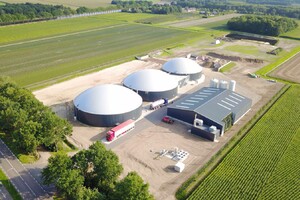Manure in, green gas out: engineering and installing a green gas installation
Biogas Plus engineers, builds, installs and maintains both biogas installations and green gas installations. There is much more potential in the latter in particular, says Bart van der Burgt, engineering and projects manager. "Green gas is a great alternative to natural gas, and the infrastructure is already there, so what more do we want?"
Text: Marion de Graaff
Source: gawalo.nl, d.d. Juli 28th 2020
In the past, biomass such as manure was converted into heat and electricity by means of a CHP installation. Nowadays, the government is increasingly focusing on green gas, which can then be fed into the natural gas network. The market for biogas installations in combination with green gas installations is therefore growing.
One of the companies that engineers, builds, installs and maintains both biogas plants and green gas plants is Biogas Plus. Bart van der Burgt is the engineering and projects manager. He is currently working on three projects in France, one project in Israel and several projects in the Netherlands.
From biogas to green gas
“Nowadays, the government is focusing more and more on green gas, which is why we are now mainly concerned with installations that turn biogas into green gas, so that it can then be fed into the natural gas network. "Get off the gas" is a common slogan, but I think you should look at that in a more nuanced way. It is about the origin and the composition. Green gas is a great alternative to natural gas, and the infrastructure is already there, so what more do we want? It is a win-win situation: on the one hand no emissions of methane and ammonia, for example, and on the other hand the production of green gas. ”
Heat from biogas
“In the past, biogas was converted into heat and power by means of a CHP installation,” says Van der Burgt. “To be able to dispose of the heat produced, a heat network is needed, which is quite difficult in the built environment. Heat from biogas is a possible solution for industry. We ourselves have experience with heating swimming pools and greenhouse complexes. Then you are talking about large local customers in the vicinity of local suppliers. ”
Manure digester for farm
With its green gas installations, Biogas Plus mainly focuses on the agricultural sector. The company developed a small standard installation for this: the compact plus manure digester (CPM). Van der Burgt explains: “The small installation is suitable for a large farm with about three hundred animals that supply manure. The manure goes into the digester and from there into a gas reprocessor. The green gas that this produces, usually about 40 cubic meters per hour, is fed into the natural gas network. "
Small installations, with an input capacity of about 11,000 tons of manure per year, are relatively easy to realize. Van der Burgt: “The permits can be arranged fairly quickly for a farm installation. That is why the lead time between application and commissioning is usually less than a year. ”
Standard plug-and-play biogas installation
“We have developed three types of small installations that are common in the agricultural sector and we sell them. By engineering and developing three standard installations and prefabricating the whole, the costs remain low. It is a plug-and-play system, as it were, delivered in a container. On location, ie in the yard, a piece of concrete construction is required in advance and the piping from the stables must be adjusted and connected. ”
“The customer is responsible for the power supply and usually engages a local installer for this. We, as the supplier of the system, take care of the maintenance. We can monitor installations from a distance, which is useful in case of malfunctions. Sometimes we can solve a problem remotely, sometimes it is necessary to send a service engineer there. ”
Medium to large biogas plant
The second type of installation that Biogas Plus supplies is the medium to large biogas installation. “This is where different fertilizer flows come together, each of which has different properties. Pig manure is thin and can easily be pumped through a pipe. Straw is always stuck to goat manure. In the summer, cows carry loads of sand into the barn with them, and that too ends up in the digester. ”
“We engineer a customized installation for every (medium) large project. We determine in advance: what goes in, what operations are needed, how long does it take before the gas is extracted from that mixture, how much gas does that produce, how do you regulate the heating, the controls, for which material and which pump system do you choose? Only then can you determine how big the installation should be and how it should be built. "




